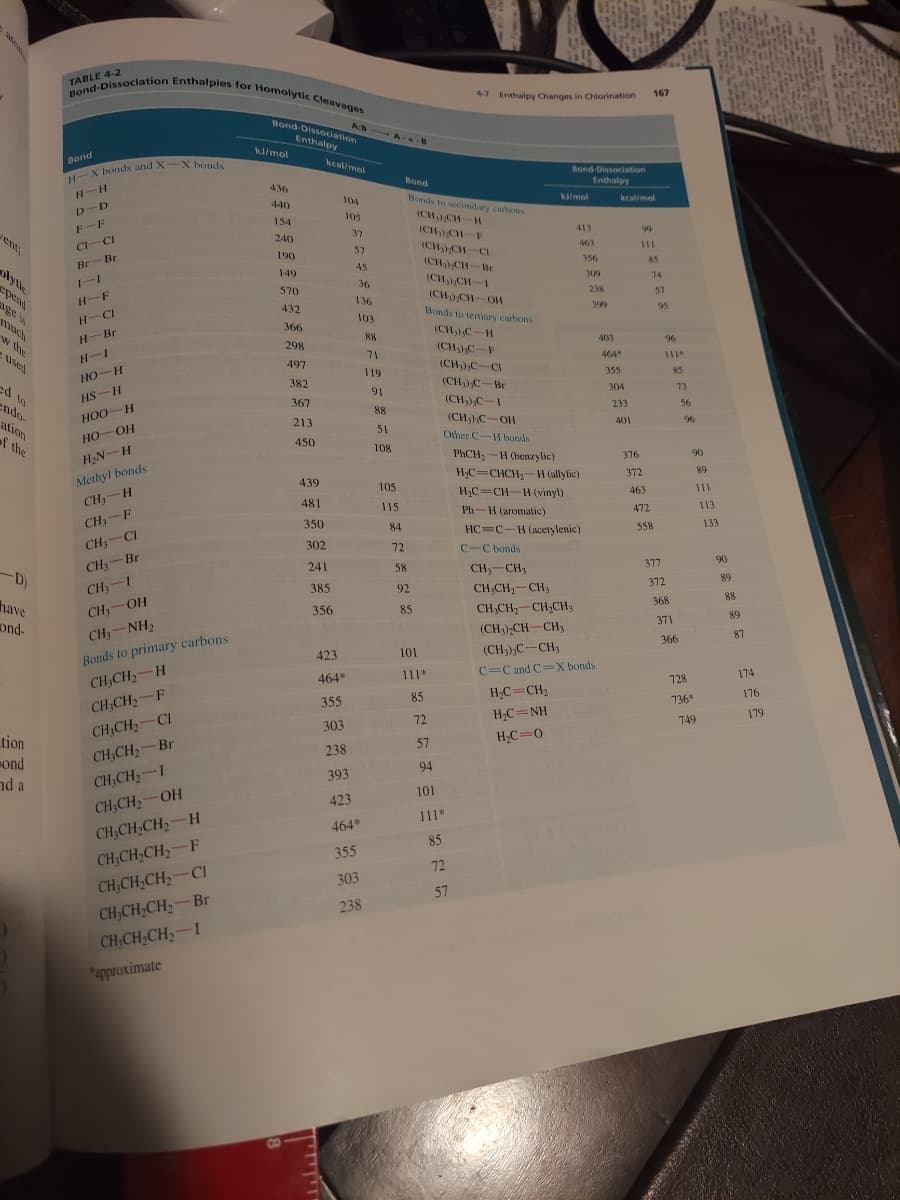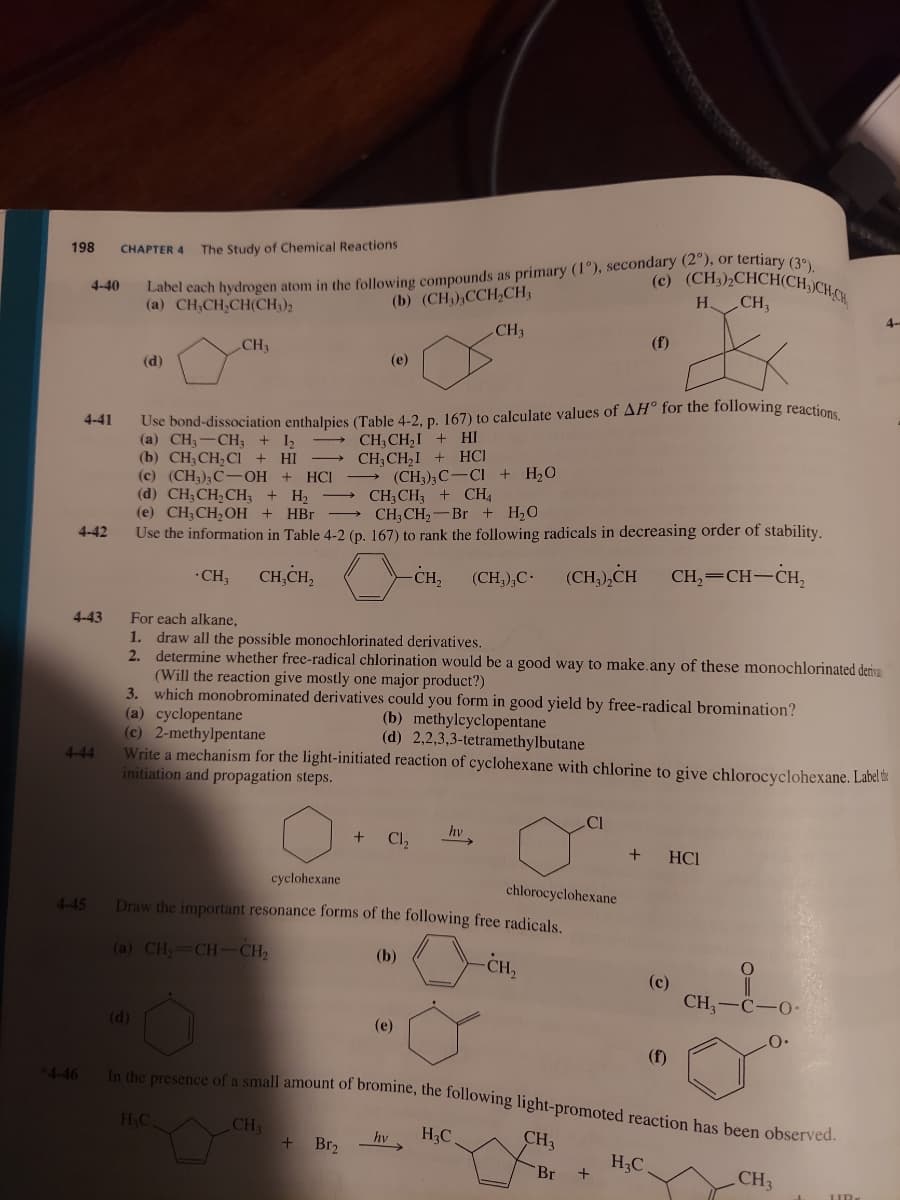Bond Enthalpy Bonds to secondary carbons kamol 104 kcalimol (CHCH-H (CHCH-F (CH) CH-CI (CH CH-Br (CH) CH-1 (CH CH-O 105 54 413 40 37 463 57 90 356 45 49 570 309 74 36 238 57 136 432 Bonds to tertiary carbons 95 103 366 (CH,)C-H 88 403 96 298 (CHC-F 71 464 497 (CHC-CI 119 355 85 382 (CH C-Br 304 73 91 367 (CH,)C-I 233 56 88 (CH3)C-OH Other C-H bonds 213 401 96 51 450 108 PHCH,-H (benzylic) 376 372 H,C=CHCH,-H (allylic) НС- СН - Н (vinyl) 439 105 463 481 115 472 Ph-H (aromatic) 350 84 HC=C-H (acetylenic) 558 302 72 C-C bonds 377 241 58 CH,-CH3 372 385 92 CH;CH-CH3 368 356 85 CH;CH2-CH;CH, 371 (CH3),CH–CH3 366 (CH)C-CH;
Bond Enthalpy Bonds to secondary carbons kamol 104 kcalimol (CHCH-H (CHCH-F (CH) CH-CI (CH CH-Br (CH) CH-1 (CH CH-O 105 54 413 40 37 463 57 90 356 45 49 570 309 74 36 238 57 136 432 Bonds to tertiary carbons 95 103 366 (CH,)C-H 88 403 96 298 (CHC-F 71 464 497 (CHC-CI 119 355 85 382 (CH C-Br 304 73 91 367 (CH,)C-I 233 56 88 (CH3)C-OH Other C-H bonds 213 401 96 51 450 108 PHCH,-H (benzylic) 376 372 H,C=CHCH,-H (allylic) НС- СН - Н (vinyl) 439 105 463 481 115 472 Ph-H (aromatic) 350 84 HC=C-H (acetylenic) 558 302 72 C-C bonds 377 241 58 CH,-CH3 372 385 92 CH;CH-CH3 368 356 85 CH;CH2-CH;CH, 371 (CH3),CH–CH3 366 (CH)C-CH;
Chapter4: Organic Compounds: Cycloalkanes And Their Stereochemistry
Section4.7: Conformations Of Monosubstituted Cyclohexanes
Problem 17P: Look at Figure 4-12 on page 105, and estimate the percentages of axial and equatorial conformations...
Related questions
Question
100%
Question 4-41
a) and b)

Transcribed Image Text:Bond-Dissociation Enthalpies for Homolytic Cleavages
Enthaley
TABLE 4-2
4-7 Enthalpy Changes in Chlorination
167
Bond-Dissociation
AB A
Enthalpy
k/mol
Bond
kcalimol
X bonds and X-Xbonds
Bond-Dissociation
Bond
436
Enthalpy
104
Bonds to secondary cartons
440
kalmol
kealimol
D-D
(CH) CH-H
(CH) CH-F
(CH) CH-CI
(CH) CH-Br
105
154
F-F
gent)
37
240
413
99
CI-CI
57
463
190
Br Br
olyti
356
45
149
1-1
(CH),CH-1
epend
309
74
36
570
(CH) CH-OH
238
H-F
57
136
432
399
much
Bonds to tertiary carbons
H-CI
95
103
366
(CH))C-H
w the
used
H-Br
88
298
403
96
(CH)C-F
H-I
71
464
497
(CH)C-CI
Но-н
119
355
85
cd to
endo.
382
(CH)C-Br
HS-H
91
304
73
367
(CH)C-1
HOO-H
88
233
56
ation
(CH3),C-OH
213
401
96
51
of the
HO-OH
Other C-H bonds
450
108
H,N-H
PHCH,-H (benzylic)
HC=CHCH2-H (allylic)
H,C=CH-H (vinyl)
376
90
Methyl bonds
-H
439
372
89
105
CH3-
11
463
481
115
CH;-F
Ph-H (aromatic)
472
113
350
84
HC=C-H(acetylenic)
558
133
CH-CI
302
72
C-C bonds
CH-Br
D)
241
58
CH3-CH3
377
90
CH-1
89
385
92
CH;CH2-CH3
372
have
ond-
CH — ОН
88
356
85
CH;CH2-CH;CH3
368
371
89
CH;-NH2
(CH3),CH-CH3
87
366
Bonds to primary carbons
101
423
(CH3),C-CH3
111*
C=C and C=X bonds
CH;CH-H
464*
728
174
85
H2C=CH2
CH,CH-F
355
176
736
72
H,C=NH
CH,CH2 CI
179
303
749
tion
H2C=0
57
CH;CH2-Br
238
ond
nd a
94
CH,CH-I
393
101
CH,CH-OH
423
111*
CH3CH,CH-H
464*
85
CH;CH,CH-F
355
72
CH;CH,CH-CI
303
57
CH;CH;CH,-Br
238
CH,CH,CH-I
approximate

Transcribed Image Text:In the presence of a small amount of bromine, the following light-promoted reaction has been observed.
Label each hydrogen atom in the following compounds as primary (1°), secondary (2), or tertiary (3
(b) (CH), ССH,CH,
198
The Study of Chemical Reactions
CHAPTER 4
(c) (CH,),CHCH(CH,)CHSH
4-40
H CH,
(a) CH,CH,CH(CH)2
4-
CH3
(f)
CH
(e)
(d)
Use bond-dissociation enthalpies (Table 4-2, p. 167) to calculate values of AH° for the following reactione
(a) CH3-CH3 + I
(b) CH;CH, CI + HI
(c) (CH;);C-OH + HCI
(d) CH;CH, CH; + H2
(e) CH; CH,OH +
Use the information in Table 4-2 (p. 167) to rank the following radicals in decreasing order of stability.
4-41
CH; CH,I + HI
CH; CH,I + HCI
(CH3);C-CI + H,O
CH CH; + CH
CH, CH,-Br + H,0
HBr
4-42
(CH,),CH
1-CH,
•CH,
CH,CH,
CH,
(CH,),C.
CH,=CH-
4-43
For each alkane,
1. draw all the possible monochlorinated derivatives.
2. determine whether free-radical chlorination would be a good way to make.any of these monochlorinated deriva
(Will the reaction give mostly one major product?)
3. which monobrominated derivatives could you form in good yield by free-radical bromination?
(a) cyclopentane
(c) 2-methylpentane
Write a mechanism for the light-initiated reaction of cyclohexane with chlorine to give chlorocyclohexane. Label te
initiation and propagation steps.
(b) methylcyclopentane
(d) 2,2,3,3-tetramethylbutane
4-44
Cl
hv
Cl,
HCL
cyclohexane
chlorocyclohexane
445
Draw the important resonance forms of the following free radicals
in,
(a) CH, CH-CH,
(b)
-CH,
(c)
CH,
-C-O·
(d)
(e)
(f)
4-46
H.C
CH
H3C
CH3
hv
Br2
H2C
Br
CH3
Expert Solution
This question has been solved!
Explore an expertly crafted, step-by-step solution for a thorough understanding of key concepts.
Step by step
Solved in 2 steps

Knowledge Booster
Learn more about
Need a deep-dive on the concept behind this application? Look no further. Learn more about this topic, chemistry and related others by exploring similar questions and additional content below.Recommended textbooks for you

